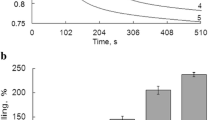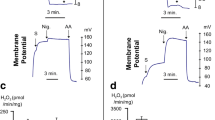Summary
The toxic effect of rubroskyrin, a modified bis-anthraquinone pigment fromPenicillium islandicum Sopp, on mitochondrial respiration has been studied by using isolated rat liver mitochondria, comparing with those of luteoskyrin and rugulosin which are well knownislandicum toxins. It was found that rubroskyrin exerted an uncoupling effect on mitochondrial respiration, abating the respiratory control ratio (RCR) by a dose dependent manner (UD50: 10 μM) and markedly depressed state 3 respiration at high concentrations, whereas such respiration-impairing effects of luteoskyrin and rugulosin were not detected at the concentrations tested (max. 35 μM). The involvement of redox-reaction was not detected in the uncoupling effect of the quinone pigment, rubroskyrin.
Spectroscopic study at various pHs revealed that rubroskyrin possessed a pK value within the range of physiological pH, suggesting that rubroskyrin is a weak acid-type uncoupler capable of conducting protons across mitochondrial inner membrane.
Similar content being viewed by others
References
Thomson RH (1971) Naturally Occurring Quinones II, Academic Press, New York and London.
Thomson RH (1987) Naturally Occurring Quinones III, Recent Advances, Chapman and Hall, London and New York.
Ghosh AC, Manmade A, Demaine AL (1977) in Mycotoxin in Human and Animal Health (Eds, Rodricks, J. U., Hesseltine, C. W., Mehlman, M. A.), Pathotox Publ. Inc., South Ill, pp625.
Turner WB, Aldridge DC (1983) Fungal Metabolites II. Academic Press, London and New York.
Uraguchi K, Saito M, Noguchi Y, Takahashi K, Enomoto M, Tatsuno T (1972) Chronic toxicity and carcinogenicity in mice of the purified mycotoxins, luteoskyrin and cyclochlorotin. Fd. Cosmet. Toxicol. 10: 193–207.
Ueno Y, Sato N, Ito T, Ueno I, Enomoto M, Tsunoda H (1974) Chronic toxicity and hepatocarcinogenicity of (−)rugulosin, an anthraquinoid mycotoxin fromPenicillium species: Preliminary survays in mice. J. Toxicol. Sci. 5:295–302.
Ueno I, Ueno Y, Tatsuno T, Uraguchi K (1964) Mitochondrial respiratory impairment by luteoskyrin, a hepatotoxic pigment ofPenicillium islandicum Sopp. Jap. J. Exp. Med. 34: 135–152.
Ueno I (1966) Action of luteoskyrin, a hepatotoxic pigment ofPenicillium islandicum Sopp, on the oxidative phosphorylation of rat liver mitochondria. Seikagaku, 38:741–747 (in Japanese).
Ueno I, Hayashi T, Ueno Y (1974) Pharmacokinetic studies on the hepatotoxicity of luteoskyrin (I). Intracellular distribution of radioactivity in the liver of mice administered with3H-luteoskyrin. Jap. J. Pharmacol. 24: 535–542.
Ueno I, Horiuchi T, Ueno Y, Sato N, Enomoto M (1978) Sex difference in liver luteoskyrin content in relation to its hepatotoxic action in mice. Toxicol. Appl. Pharmacol. 46: 1–7.
Kawai K, Nozawa Y, Mori H, Ogihara Y (1968) Inhibition of mitochondrial respiration by flavoskyrin, a toxic metabolite ofPenicillium islandicum Sopp. Toxicol. Lett. 30: 105–111.
Umeda M, Saito M, Shibata S (1974) Comparison of cytotoxic effects of various anthraquinoids on cultured mammalian cells. Jap. J. Exp. Med. 44:249–255.
Takeda N, Seo S, Ogihara Y, Sankawa U, Iitaka I, Kitagawa I, Shibata S (1973) Studies on fungal metabolites-XXXI. Anthraquinoid coloring matters ofPenicillium islandicum Sopp and some other fungi, (−)luteoskyrin, (−)rubroskyrin, (+)rugulosin and their related compounds. Tetrahedron 29:3703–3719.
Mori S, Kawai K, Nozawa Y, Koyama K, Natori S (1993) The impairing effects of chaetochromin D on mitochondrial respiration and structure. Mycotoxin Res. 9:4–13.
Chance B, Williams GR (1956) The respiratory chain and oxidative phosphorylation.In: Advances in Enzymol. (ed. Nord FF) Interscience Publishers. New York, Vol. 17:pp 65–134.
Lowry OH, Rosebrough AL, Farr AL, Randall RJ (1951) Protein measurement with Folin phenol reagent. J. Biol. Chem. 193: 265–275.
Kawai K, Hisada K, Mori S, Nozawa Y (1992) Molecular approach to the toxic action of quinone mycotoxins. Chemical structure and biochemistryin Current Topics in Medical Mycology (eds. Borgers M, Hay R, Rinaldi MG) Spring-Verlag, NewYork, Vol. 4: pp207–230.
McLaughlin SGA, Dilger JP (1980) Transport of protons across membranes by weak acids. Physiol. Rev. 60: 825–863.
Ueno Y, Ueno I, Ito K, Tatsuno T (1967) Impairment of RNA synthesis in Ehrlich ascites tumour cells by luteoskyrin, a hepatotoxic pigment ofPenicillium islandicum Sopp. Experientia 23: 1001–1002.
Tashiro F, Hirai K, Ueno Y (1979) Inhibitory effects of carcinogenic mycotoxin on DNA-dependent RNA polymelase and RNase H. Appl. Environment. Microbiol. 38:191–196.
Akuzawa S, Yamaguchi H, Masuda T, Ueno Y (1991) Radical-mediated modification of deoxyguanine and deoxyribose by luteoskyrin and related anthraquinones. Mutation Res. 266: 63–69.
Author information
Authors and Affiliations
Rights and permissions
About this article
Cite this article
Mori, S., Sugihara, Y., Kitagawa, A. et al. The respiration-impairing effect of rubroskyrin, a toxic metabolite. Mycotox Res 12, 91–98 (1996). https://doi.org/10.1007/BF03192267
Received:
Accepted:
Issue Date:
DOI: https://doi.org/10.1007/BF03192267




